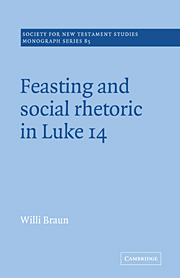Book contents
- Frontmatter
- Contents
- Acknowledgements and note on abbreviations
- 1 Introduction: how to read Luke 14?
- 2 Assumptions and preliminary reading
- 3 Jesus as a healer of craving desire (14.1–6)
- 4 Uncommon ‘symposium rules’ (14.7–11, 12–14)
- 5 The big dinner (14.15–24): aspects of Lukan performance
- 6 The conversion of a wealthy householder
- 7 Forms, genres and composition
- 8 Composition as argumentation: the rhetoric of Luke 14
- 9 Towards closure (and openings)
- Bibliography
- Indices
2 - Assumptions and preliminary reading
Published online by Cambridge University Press: 28 August 2009
- Frontmatter
- Contents
- Acknowledgements and note on abbreviations
- 1 Introduction: how to read Luke 14?
- 2 Assumptions and preliminary reading
- 3 Jesus as a healer of craving desire (14.1–6)
- 4 Uncommon ‘symposium rules’ (14.7–11, 12–14)
- 5 The big dinner (14.15–24): aspects of Lukan performance
- 6 The conversion of a wealthy householder
- 7 Forms, genres and composition
- 8 Composition as argumentation: the rhetoric of Luke 14
- 9 Towards closure (and openings)
- Bibliography
- Indices
Summary
A detailed analysis of Luke 14.1–24 in later chapters begs for treatment of some preliminary matters. First, it is appropriate to outline several elements of a canopy of assumptions concerning the characteristics of Lukan authorship and manner of composition in whose shade I plan to work.
Second, as a matter of strategy, I use the banquet parable (14.16–24) as a launching point for sketching the most obvious lines along which the parable has been integrated into the larger textual unit of 14.1–24. In part, the use of the parable as the vantage point from which to survey the narrative episode in which it resides is an expedient means of demonstrating the thematic unity of 14.1–24. Additionally, the move from parable to context helps to justify my resistance (see ch. 1) to studying parables in vacuo, and to illustrate, rather, what might be gained by assigning procedural priority to the banquet story's Sitz in der Literatur as a path towards discovering the particularly Lukan dimensions of the story and the role that it plays in the thematic and argumentative structure of the sabbath dinner episode.
The most recent decades have been a productive period of research on the nature of Lukan authorship and the literary and generic characteristics of Luke-Acts. I draw from it the following assumptions whose importance for the study of the banquet story will become apparent.
- Type
- Chapter
- Information
- Feasting and Social Rhetoric in Luke 14 , pp. 8 - 21Publisher: Cambridge University PressPrint publication year: 1995

